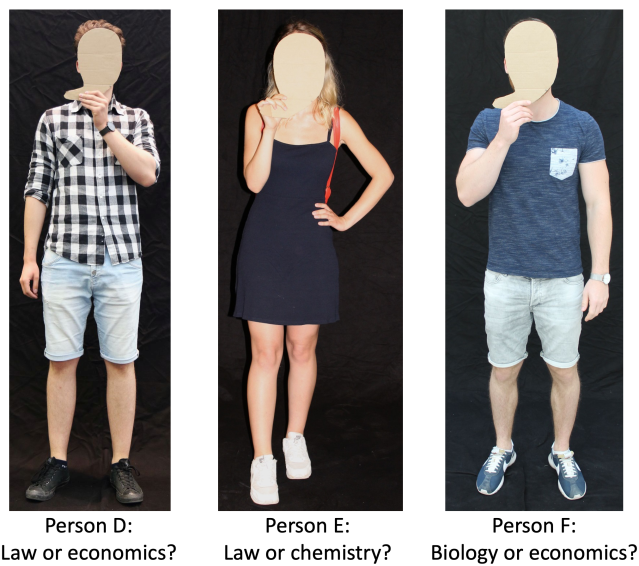Social Networking
Student Dressing Habits: The Influence of Super Weak Ties
Can you tell who is studying what by the way they dress?
Posted July 3, 2024 Reviewed by Gary Drevitch
At Goethe University in Frankfurt, Germany, a study was conducted to determine if students' clothing could indicate their area of study.
If it were possible to recognize a course by its clothing, we could say that cultures have developed around clothing. We photographed students from four different study programs. We then presented these photos to other students (290 people). They were then asked for their opinion as to which course the people in the photos belonged to. This approach is simpler than classifying clothing by counting how often certain types of trainers are worn, for example. The students were asked to identify whether they were studying chemistry, biology, economics, or law.
You can see the experiment for yourself with a small example. I present some of the pictures here. Try to match them yourself and see if you can find the right subject. The majority of students got it right. You can find the solution at the end of the post.
Successful assignments: Which subject is the person pictured studying? The expected value for a randomly correct assignment is 50%.

Sometimes the program is difficult to identify
If the clothing is not fundamentally different in the different countries and places, you may have done the assignment correctly. Students in Frankfurt am Main (Germany) had much more difficulty with the following pictures. Here, the majority of students were wrong.

In most cases, the majority can tell what someone is studying by what they are wearing. Despite several misclassifications, most students were correct in their comparisons. We made 20 such comparisons, and the majority of respondents were correct in 14 of them. See the table below:
Comparison between departments - the majority of assignments correct or incorrect
- Law/Biology: all 4 correct
- Law/Chemistry: all 3 correct
- Economics/Biology: all 2 not correct
- Economics/Chemistry: The one comparison was not correct
- Law/Economics: Out of 5 comparisons 3 correct/ 2 not correct
- Biology/Chemistry: Out of 5 comparisons 4 correct/ 1 not correct
20 comparisons in total (14 majority correct)
Therefore, it can be said that in the majority of cases, it is possible to tell what subject the students are studying by their clothing.
What is the explanation for this?
Students often observe how others are dressed in a classroom or lecture hall, and this leads to a comparison between their attire and that of others. As a result, students may end up adopting the styles of dress they see around them. This phenomenon can be explained by "superweak" relationships, which are based solely on the fact that individuals can observe others when they are in the same place at the same time. If this assumption is correct, it may help explain how specific cultures associated with different subjects develop.
Some students anticipate the clothing styles of their future jobs, which they may be familiar with from internships or student activities. In some cases, students may already know how to dress for a particular profession, especially if the profession is commonly passed down from parent to child. This is particularly notable for law in Germany.
Knowledge about the clothing habits of students
However, it is not just about the clothing style itself. It is also about recognizing different styles. To do this, you must have knowledge of culture. You can gain this knowledge by observing and sometimes by hearing stories about typical clothing styles. Apparently, the students surveyed not only have knowledge about the clothing style of their own subject area, but also about that of other degree programs. Stereotypes are also likely to play a role here. This can also be seen in the cases where it was not possible to identify the degree course. So, you can see: The clothes usually say something about the course of study.
Solutions
Person A: Chemistry (95% correct), Person B: Biology (87%), Person C: Law (75%),
Person D: Law (34%), Person E: Chemistry (21%), Person F: Biology (25%)
A total of 290 students at Goethe University Frankfurt were surveyed.
You can read more about the explanation of the connection between clothing and study programs in my book Super Weak Ties. Springer: Wiesbaden, published in 2024.
References
Stegbauer, Christian. 2024. Super Weak Ties. What Culturally Holds our Society Together. Wiesbaden: Springer.


